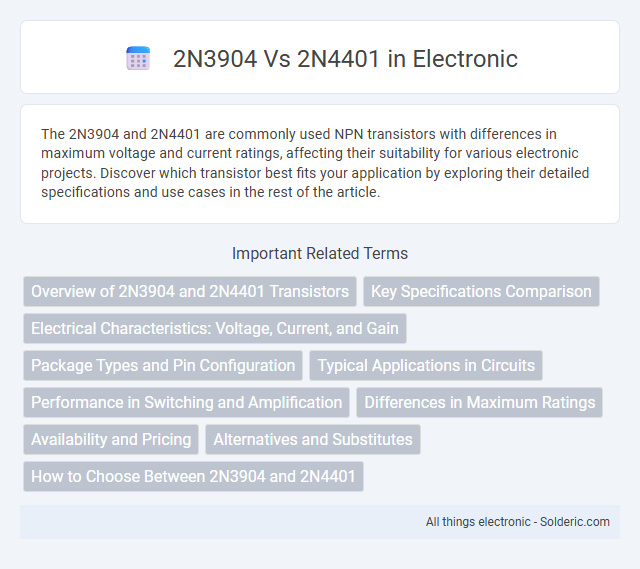The 2N3904 and 2N4401 are commonly used NPN transistors with differences in maximum voltage and current ratings, affecting their suitability for various electronic projects. Discover which transistor best fits your application by exploring their detailed specifications and use cases in the rest of the article.
Comparison Table
| Parameter | 2N3904 | 2N4401 |
|---|---|---|
| Type | NPN Bipolar Junction Transistor | NPN Bipolar Junction Transistor |
| Maximum Collector-Emitter Voltage (Vce) | 40 V | 40 V |
| Maximum Collector Current (Ic) | 200 mA | 600 mA |
| Power Dissipation (Ptot) | 625 mW | 625 mW |
| Transition Frequency (ft) | 300 MHz | 250 MHz |
| Gain Bandwidth Product (hFE) | 100 - 300 (varies by collector current) | 40 - 300 (varies by collector current) |
| Package Type | TO-92 | TO-92 |
| Applications | Low power switching, amplification, general purpose | Medium power switching, amplification, driving loads |
Overview of 2N3904 and 2N4401 Transistors
The 2N3904 and 2N4401 are both NPN bipolar junction transistors commonly used in switching and amplification applications, with the 2N3904 featuring a maximum collector current of 200mA and a transition frequency around 300MHz. The 2N4401 offers a higher maximum collector current of 600mA and is designed for higher power and voltage handling, making it suitable for more demanding circuit designs. Your choice between these transistors depends on current capacity and frequency requirements in your electronic projects.
Key Specifications Comparison
The 2N3904 and 2N4401 are both commonly used NPN bipolar junction transistors with similar voltage ratings, but the 2N4401 typically supports higher collector current, up to 600mA compared to the 2N3904's 200mA. Both transistors have a maximum collector-emitter voltage of around 40V, but the 2N4401 generally offers higher gain bandwidth product, making it suitable for medium power switching and amplification. Your choice between these transistors depends on the required current handling and gain performance for your specific circuit application.
Electrical Characteristics: Voltage, Current, and Gain
The 2N3904 transistor features a maximum collector-emitter voltage (Vce) of 40V and a collector current (Ic) up to 200mA, with a typical current gain (hFE) ranging from 100 to 300. In comparison, the 2N4401 offers a higher Vce of 40V, a greater Ic rating of 600mA, and a current gain that typically falls between 40 and 160. Your choice between these transistors depends on the specific voltage, current, and gain requirements of your electronic circuit.
Package Types and Pin Configuration
The 2N3904 transistor is commonly found in a TO-92 plastic package with a standard pin configuration of Emitter-Base-Collector when viewed from the flat side with leads down. The 2N4401 usually also comes in a TO-92 package but features different pin arrangements where the collector is in the middle, and the emitter and base flank it on either side. The slight variations in pin configuration between these two NPN transistors require careful attention during PCB layout and circuit design to ensure proper functionality.
Typical Applications in Circuits
The 2N3904 transistor is widely used for low-power switching and amplification tasks in audio, signal processing, and general-purpose circuits due to its high gain and low noise characteristics. The 2N4401 is preferred for medium-power switching and amplifier circuits, often found in power regulators, motor controllers, and relay drivers thanks to its higher current and voltage ratings. Choosing the right transistor depends on your circuit's power requirements and signal handling needs, with the 2N3904 suited for low-current applications and the 2N4401 for more robust, higher-current scenarios.
Performance in Switching and Amplification
The 2N3904 and 2N4401 transistors both excel in switching and amplification tasks, with the 2N4401 offering higher current handling capacity up to 600mA compared to the 2N3904's 200mA, making it more suitable for power-intensive switching applications. The 2N3904 features higher transition frequency (fT) around 300MHz, favoring faster switching speeds and better performance in high-frequency amplification. Your choice depends on whether high-speed switching or higher current amplification is more critical for your electronic circuit design.
Differences in Maximum Ratings
The 2N3904 transistor has a maximum collector-emitter voltage (Vce) rating of 40V, whereas the 2N4401 supports a higher voltage of up to 60V, making it more suitable for higher voltage applications. The 2N3904's maximum collector current (Ic) is 200mA, which is lower compared to the 2N4401's 600mA, allowing the latter to handle more load current. Power dissipation ratings also differ, with the 2N4401 capable of dissipating up to 625mW, significantly higher than the 2N3904's 350mW, enhancing its thermal performance in demanding circuits.
Availability and Pricing
The 2N3904 transistor is widely available and typically priced lower due to its mass production and common use in general-purpose applications. The 2N4401, while also commonly available, tends to be slightly more expensive because it is often chosen for higher current and voltage handling capabilities in more specialized circuits. Both transistors can be easily sourced from major electronics distributors, but bulk purchasing usually results in more significant cost savings for the 2N3904.
Alternatives and Substitutes
The 2N3904 and 2N4401 transistors are both popular NPN bipolar junction transistors commonly used in low-power amplification and switching applications. Alternatives to the 2N3904 include the 2N2222 and BC547, which offer similar gain and switching speeds, while substitutes for the 2N4401 often involve the 2N2219 or PN2222, known for their comparable current ratings and voltage handling. When selecting substitutes, consider parameters such as maximum collector current, gain bandwidth product, and package type to ensure compatibility with the original circuit requirements.
How to Choose Between 2N3904 and 2N4401
When choosing between 2N3904 and 2N4401 transistors, consider their current and power ratings: the 2N4401 supports higher collector current up to 600mA, making it suitable for medium-power switching applications, while the 2N3904 handles lower currents around 200mA, ideal for general-purpose amplification. Your decision should align with the load requirements and switching speed, as 2N4401 offers lower saturation voltage and better switching performance under higher loads. Evaluating these parameters ensures optimal transistor selection for your electronic circuit needs.
2N3904 vs 2N4401 Infographic

 solderic.com
solderic.com